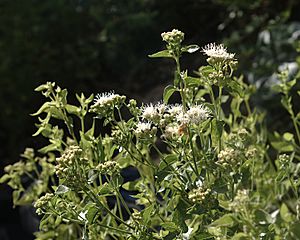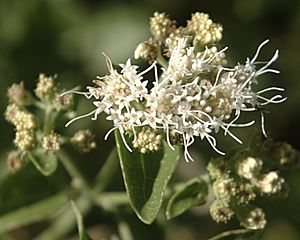Fragrant snakeroot facts for kids
Quick facts for kids Fragrant snakeroot |
|
|---|---|
 |
|
| Scientific classification | |
| Synonyms | |
|
Synonymy
Eupatorium ageratifolium var. herbaceum A.Gray
Eupatorium arizonicum (A.Gray) Greene Eupatorium arizonicum (A.Gray) A.Nelson Eupatorium betulifolium (Greene) B.L.Rob. Eupatorium herbaceum (A.Gray) Greene Eupatorium occidentale var. arizonicum A.Gray Kyrstenia arizonica (A.Gray) Greene Kyrstenia betulifolia Greene Kyrstenia herbacea (A.Gray) Greene |
Ageratina herbacea is a cool plant from North America. People often call it fragrant snakeroot or Apache snakeroot. It's part of the daisy family, just like sunflowers! You can find this plant growing in the hot, dry desert areas of the southwestern United States and northern Mexico. It loves rocky hillsides in forests.
Contents
Fragrant Snakeroot: What It Is
This plant is a perennial herb, which means it lives for more than two years. It has a green, fuzzy stem that grows from a tough, woody base called a caudex. The stem can reach about 50 to 70 centimeters tall. This is roughly knee-high to waist-high for a kid. Its leaves are usually yellow-green or grayish. They are shaped like a triangle or a heart.
Where This Plant Lives
Fragrant snakeroot is native to the desert regions of North America. These include the Sonoran Desert, Mojave Desert, and Chihuahuan Desert. You can find it in places like southeastern California, southern Nevada, and southern Utah. It also grows in Colorado, Arizona, New Mexico, and western Texas. In Mexico, it lives in Baja California, Chihuahua, Coahuila, and Sonora. It prefers to grow on rocky slopes in conifer forests and woodlands.
How Its Flowers and Seeds Grow
The flowers of the fragrant snakeroot grow in fuzzy bunches. These are called flower heads. Each flower head is quite small, less than a centimeter long. They have long, white, tube-shaped flowers called disc florets that stick out. Interestingly, these plants do not have the flat, petal-like flowers you see on a daisy. Those are called ray florets.
After the flowers bloom, the plant produces small fruits. These fruits are called achenes. They are only a few millimeters long. Each achene has a rough, bristly top part called a pappus. This pappus helps the seeds float away in the wind.
Why It's Called Fragrant Snakeroot
The scientific name for this plant is Ageratina herbacea. The first part, Ageratina, comes from an old Greek word. It means 'un-aging'. This name was given because the flowers keep their color for a long time. An ancient Greek doctor named Dioscorides used this name for different plants. The common names, fragrant snakeroot and Apache snakeroot, come from its smell and where it grows.


